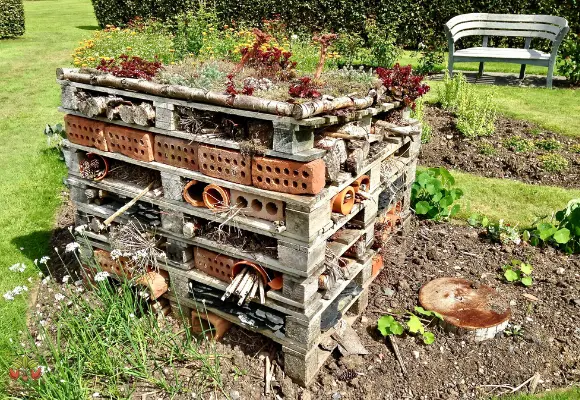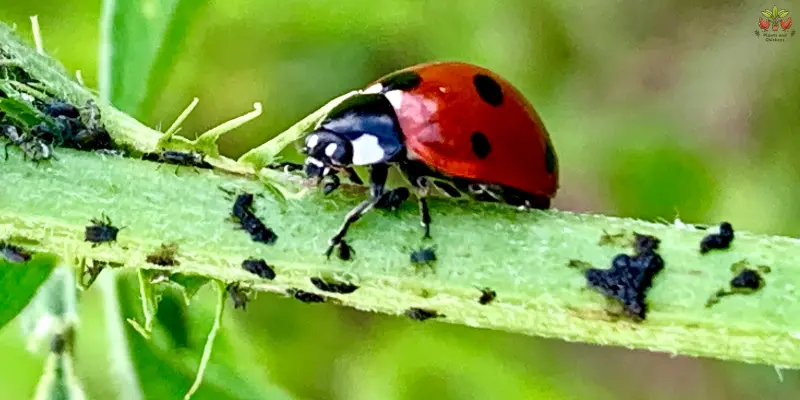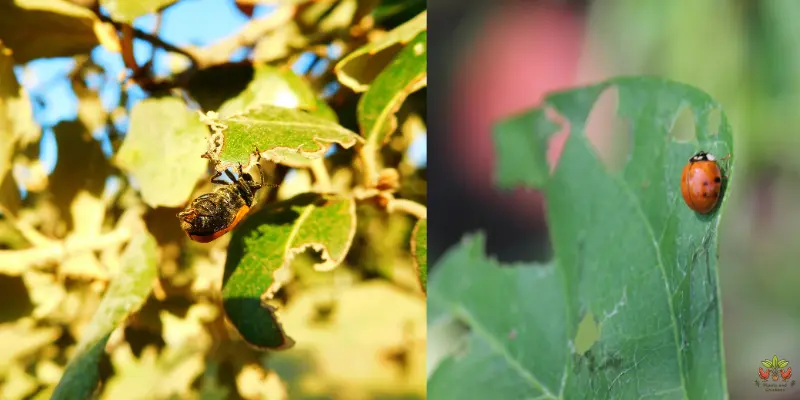Do Ladybugs Eat Plants? The answer is Ladybugs do not eat plants, but they are actually beneficial for your garden as they consume aphids and other pests that harm your plants. To protect your garden, it is important to attract and encourage ladybugs to visit and stay by creating a suitable environment for them.
Introducing ladybugs to your garden can be an eco-friendly and effective method of pest control. These small insects are known to feed on many types of pests, including aphids, mites, scale insects, and small caterpillars. By consuming these pests, ladybugs can help maintain a natural balance in your garden ecosystem, which in turn allows your plants to grow healthier.
This article will provide insights into the benefits of ladybugs in a garden, You will get answers for do ladybugs eat plants or not, how to attract them, and how to ensure their survival.
Table of Contents
The Role Of Ladybugs In The Garden
The presence of ladybugs in the garden is not just a delight to the eyes; it is also incredibly beneficial for your plants. These charming insects, with their vibrant colors and innocent appearance, play a crucial role in maintaining a healthy and thriving garden ecosystem. Ladybugs are not only a natural predator to many common garden pests, but they also help in pollination. Let’s take a closer look at the various reasons why ladybugs are a gardener’s best friend.
Why Ladybugs Are Beneficial For Gardens
Ladybugs, also known as lady beetles or ladybird beetles, are beloved by gardeners for their impressive pest control abilities. They are renowned for their voracious appetite, particularly for aphids, which can be a menace to your prized plants. A single ladybug can devour up to 5,000 aphids in its lifetime. This natural pest control method not only helps to keep your garden pest-free but also reduces the need for harmful chemical pesticides that can harm beneficial insects and the environment.
Moreover, ladybugs are also a valuable addition to your garden because they are attracted to pollen and nectar. They feed on these plant substances, which aid in the pollination process. This promotes the growth and reproduction of your plants, leading to healthier and more bountiful harvests. With ladybugs in your garden, you can expect an increase in both the quality and quantity of your crops.
How Ladybugs Help Control Garden Pests
Ladybugs are a true ally when it comes to pest control in the garden. Aside from aphids, they also have a taste for soft-bodied insects such as mites, mealybugs, whiteflies, and scale insects. Their appetite for these pests makes them an invaluable asset in keeping your garden free from infestations that can damage or kill your plants.
These beneficial insects are not only efficient predators, but they are also highly adaptable. Ladybugs can seek out pest infestations on plants, both in the garden and greenhouse environments. They are even known to consume agricultural pests like thrips, leafhoppers, and spider mites. Ladybugs are skilled hunters, capable of tracking down their prey with precision and devouring them without mercy.
Not only do ladybugs consume pests, but they also lay their eggs nearby to ensure a steady supply of food for their growing larvae. The larvae, often mistaken for pests themselves due to their spiky appearance, are actually highly efficient predators. They feed voraciously on garden pests, ensuring that the cycle of natural pest control continues in your garden.
In addition to their hunting skills, ladybugs also benefit from a unique defense mechanism. When they sense danger, they exude a yellowish substance known as hemolymph, which repels predators. This defensive secretion serves as a warning to potential threats, keeping ladybugs safe while they go about their pest control duties.

Do Ladybugs Eat Plants?
When it comes to managing pests in your garden, ladybugs are often seen as one of the most beneficial insects to have around. Their vibrant appearance and voracious appetite for pests make them a natural choice for organic gardeners. But, you may wonder: do ladybugs eat plants? Let’s delve into the diet of these polka-dotted wonders and understand how they contribute to a healthy garden ecosystem.
Understanding The Diet Of Ladybugs
Ladybugs, scientifically known as lady beetles, belong to the family Coccinellidae. While they predominantly feast on aphids, they have a diverse palate that extends beyond plant pests. However, the short answer to whether ladybugs eat plants is no, they do not devour your prized blooms or fresh greens. Instead, they feast on a wide range of soft-bodied insects, mites, and even the eggs of pests that wreak havoc on your plants.
What Ladybugs Feed On In The Garden
Now, let’s take a closer look at what makes up the menu of ladybugs in your garden:
By understanding what ladybugs eat, you can see why they are such a valuable asset to any garden. They provide natural pest control without causing harm to your plants, making them an eco-friendly alternative to chemical pesticides.
Remember, providing a habitat that attracts ladybugs to your garden can help keep the pest population in check. This can be achieved by planting diverse flora that produces pollen and nectar, such as daisies, marigolds, and herbs like dill and fennel. Offering them a comfortable shelter, such as a ladybug house or brush piles, can also encourage them to stick around and continue their pest-munching efforts.
In conclusion, ladybugs do not eat plants. Instead, they dine on pests that feast on your plants, acting as your garden’s own miniature insect army. By understanding their diet and fostering a ladybug-friendly environment, you can harness the power of these colorful allies to protect your garden naturally.
Protecting Your Garden With Ladybugs
Ladybugs are not only charming insects but also beneficial allies in the battle against plant-destroying pests. By attracting and introducing ladybugs to your garden, you can create a natural pest control system that safeguards your plants without resorting to harmful chemicals. In this article, we will explore effective methods to attract ladybugs to your garden and safely introduce them to your plants, ensuring a thriving and well-protected garden.
Attracting Ladybugs To Your Garden
There are several simple yet effective ways to entice ladybugs into your garden. By providing them with an appealing habitat, you can encourage these helpful insects to make themselves at home, ready to take on any unwanted pests.
Here are a few tried-and-true methods to attract ladybugs:

Methods To Safely Introduce Ladybugs To Your Garden
Once you’ve successfully attracted ladybugs to your garden, you may want to consider introducing them directly to your plants to tackle pest infestations. Taking the following steps will ensure a safe and effective introduction:
By employing these methods to attract and safely introduce ladybugs to your garden, you can create a harmonious balance between your plants and their natural protectors. Ladybugs not only enhance the beauty of your garden but also play a vital role in maintaining its health and overall well-being.
Frequently Asked Questions For Do Ladybugs Eat Plants All You Need To Know To Protect Your Garden
Do Ladybugs Eat Plants?
Ladybugs primarily eat insects such as aphids, mealybugs, and mites. They are considered beneficial to gardens as they help control pests naturally, reducing the need for pesticides.
How Do Ladybugs Help Protect Your Garden?
Ladybugs are natural predators and feed on harmful pests like aphids and mites that can damage plants. By keeping these pests in check, ladybugs help protect your garden and promote a healthy ecosystem.
How Can I Attract Ladybugs To My Garden?
To attract ladybugs, plant nectar-rich flowers like daisies, marigolds, and yarrow. Also, avoid using insecticides, as these can harm ladybugs and other beneficial insects. Providing shelter like rocks or logs can also encourage ladybugs to make your garden their home.
Conclusion
To keep your garden thriving, understanding the role of ladybugs is crucial. These small, vibrant insects are more than just a delightful sight—they play a vital role in controlling pests that could harm your plants. By preying on aphids and other garden pests, ladybugs act as natural pest control agents.
Encourage ladybug populations in your garden by providing suitable habitat and avoiding the use of harmful pesticides. Let these helpful creatures keep your plants safe and flourishing naturally. Happy gardening!


![Terrifying Trend: Why Do Roosters Chase Humans? [2024]](https://plantsandchickens.com/wp-content/uploads/2024/02/why-do-roosters-chase-humans-4.webp)


Leave a Reply